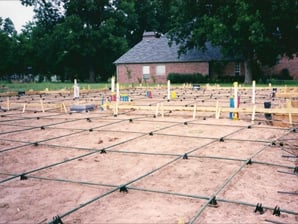In Oklahoma, our soil has high clay content, so it expands and contracts easily with the weather. A heavy rain can cause expansion, and lead to extra pressure on your home's slab. A dry spell can cause contraction, which leads to empty voids underneath. Either way, you're looking at potential foundation and structural issues. Enter the post-tension slab system. This method allows the slab to move with the soils, which prevents the slab from separating and causing structural issues.
At Capital Homes, we work with StressCon to ensure each home has the best line of defense against that moving clay. Here's how it works:
"The Stress-Con Post Tension System uses a high strength seven strand steel cable with a coating of lubricant and plastic.
The cable is installed inside the concrete form boards according to engineering specifications. A typical installation includes cables in both directions to form a reinforcement grid. The cables are supported by plastic chairs and have steel anchors attached at each end.

After the concrete has been placed and set to meet specifications, the tensioning process (called stressing), is applied to the cables. The stressing operation is accomplished using a hydraulic jack which attaches to the protruding cable end after the forms have been removed. The lubricant inside the plastic liner allows the cable to slide while the pressure is being applied. After the cable has been stressed, it is locked in place by steel wedges in the anchorage assembly. Upon completion of stressing, the slab is in a state of compression, applied at the anchor points of each cable end.

The residual compression distributed throughout the slab supports the structure on top, and actively resists soil movement occurring under the slab. The StressCon System exponentially increases stability in the normal life of the structure."



